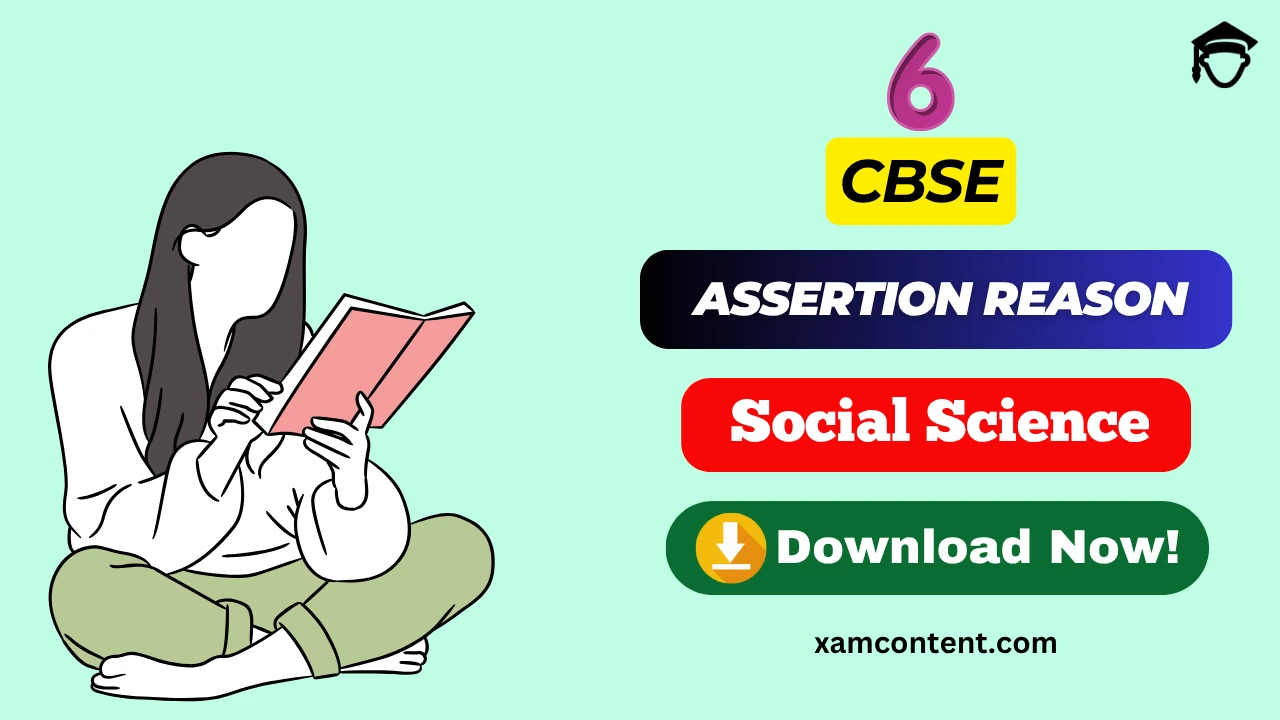Hello students, we are providing assertion reason questions for class 6. Assertion Reason questions are the new question format that is introduced in CBSE board. The resources for assertion reason questions are very less. So, to help students we have created chapterwise assertion reason questions for class 6 Social Science. In this article, you will find assertion reason questions for CBSE Class 6 Social Science Chapter 7 India’s Cultural Roots. It is a part of Assertion Reason Questions for CBSE Class 6 Social Science Series.
| Chapter | India’s Cultural Roots |
| Type of Questions | Assertion Reason Questions |
| Nature of Questions | Competency Based Questions |
| Board | CBSE |
| Class | 9 |
| Subject | Social Science |
| Useful for | Class 6 Studying Students |
| Answers provided | Yes |
| Difficulty level | Mentioned |
| Important Link | Class 6 Social Science Chapterwise Assertion Reason |
Assertion Reason Questions on India’s Cultural Roots
Q1. Assertion (A): Indian culture is one of the oldest and richest cultures in the world.
Reason (R): It has evolved over thousands of years through interactions of different communities.
(a) Both A and R are true and R is the correct explanation of A.
(b) Both A and R are true but R is not the correct explanation of A.
(c) A is true but R is false.
(d) A is false but R is true.
Show Answer
Ans: (a)
Explanation: Both statements are true and related; India’s diverse heritage developed through centuries of social and cultural exchange.
Q2. Assertion (A): The Vedas are the earliest written texts of Indian civilization.
Reason (R): They are collections of hymns, rituals, and philosophical ideas.
(a) Both A and R are true and R is the correct explanation of A.
(b) Both A and R are true but R is not the correct explanation of A.
(c) A is true but R is false.
(d) A is false but R is true.
Show Answer
Ans: (a)
Explanation: Both are true and connected; the four Vedas form the foundation of early Indian religious and literary tradition.
Q3. Assertion (A): Buddhism and Jainism originated in China and later spread to India.
Reason (R): Both religions emphasized truth, non-violence, and compassion.
(a) Both A and R are true and R is the correct explanation of A.
(b) Both A and R are true but R is not the correct explanation of A.
(c) A is true but R is false.
(d) A is false but R is true.
Show Answer
Ans: (d)
Explanation: The assertion is false; Buddhism and Jainism originated in India itself, not China.
Q4. Assertion (A): The Ramayana and Mahabharata are examples of epics that teach moral and social values.
Reason (R): These texts reflect the ideals of dharma and righteousness.
(a) Both A and R are true and R is the correct explanation of A.
(b) Both A and R are true but R is not the correct explanation of A.
(c) A is true but R is false.
(d) A is false but R is true.
Show Answer
Ans: (a)
Explanation: Both statements are true and connected; the epics embody India’s ethical and cultural values.
Q5. Assertion (A): Temples in ancient India were simple structures without decoration.
Reason (R): With time, temples evolved into grand monuments with intricate carvings and art.
(a) Both A and R are true and R is the correct explanation of A.
(b) Both A and R are true but R is not the correct explanation of A.
(c) A is true but R is false.
(d) A is false but R is true.
Show Answer
Ans: (d)
Explanation: The assertion is false; later temples became highly ornate, showcasing India’s artistic growth.
Q6. Assertion (A): Sanskrit was the only language used in all ancient Indian texts.
Reason (R): Regional languages like Pali and Prakrit were also used for religious teachings.
(a) Both A and R are true and R is the correct explanation of A.
(b) Both A and R are true but R is not the correct explanation of A.
(c) A is true but R is false.
(d) A is false but R is true.
Show Answer
Ans: (d)
Explanation: The assertion is false; other languages like Pali and Prakrit were widely used, especially in Buddhist and Jain literature.
Q7. Assertion (A): Indian festivals often reflect the unity of diverse traditions.
Reason (R): Festivals like Diwali, Holi, and Eid promote harmony among communities.
(a) Both A and R are true and R is the correct explanation of A.
(b) Both A and R are true but R is not the correct explanation of A.
(c) A is true but R is false.
(d) A is false but R is true.
Show Answer
Ans: (a)
Explanation: Both are true and related; India’s festivals strengthen cultural bonds and unity in diversity.
Q8. Assertion (A): Art, music, and dance in India have been influenced by external cultures.
Reason (R): Cultural exchange through trade and invasions enriched Indian art forms.
(a) Both A and R are true and R is the correct explanation of A.
(b) Both A and R are true but R is not the correct explanation of A.
(c) A is true but R is false.
(d) A is false but R is true.
Show Answer
Ans: (a)
Explanation: Both statements are true and linked; India absorbed and transformed foreign influences into its own cultural identity.
We hope the given assertion reason questions with Answers for India’s Cultural Roots Class 6 helps you in your learning.

Also check
- Class 6 Social Science Assertion Reason Questions Chapter 10 – Grassroots Democracy Part 1 Governance
- Class 6 Social Science Assertion Reason Questions Chapter 9 – Family and Community
- Class 6 Social Science Assertion Reason Questions Chapter 8 – Unity in Diversity
- Class 6 Social Science Assertion Reason Questions Chapter 7 – India’s Cultural Roots
- Class 6 Social Science Assertion Reason Questions Chapter 6 – The Beginings of Indian Civilisation
- Class 6 Social Science Assertion Reason Questions Chapter 5 – India, that is Bharat
- Class 6 Social Science Assertion Reason Questions Chapter 4 – Timeline and Sources of History
- Class 6 Social Science Assertion Reason Questions Chapter 3 – Landforms and Life
- Class 6 Social Science Assertion Reason Questions Chapter 2 – Ocean and Continents
- Class 6 Social Science Assertion Reason Questions Chapter 1 – Locating Places on Earth
Topics from which assertion reason questions may be asked
- The Vedas and Vedic culture
- Upaniṣads and early schools of thought
- Contribution of folk and tribal traditions
Assertion reason questions from the above given topic may be asked.

You may also like

Frequently Asked Questions (FAQs) on India’s Cultural Roots Assertion Reason Questions Class 6
Q1: What are Assertion Reason Questions in Class 6 Social Science?
A1: Assertion Reason Questions are a new type of competency-based questions where students are given two statements — an Assertion (A) and a Reason (R). Students must decide whether each statement is true and whether the Reason correctly explains the Assertion.
Q2: How can Assertion Reason Questions help in exam preparation?
A2: These questions help students think critically, understand cause–effect relationships, and go beyond rote learning. They strengthen conceptual clarity in topics like History, Geography, and Civics by testing logical connections between facts.
Q3: How should students approach Assertion Reason Questions?
A3: Students should first read both statements carefully, identify whether each is true or false, and then check if the Reason actually explains the Assertion. Practicing chapter-wise Assertion Reason sets regularly improves accuracy and speed.
Q4: Are Assertion Reason Questions included in CBSE Class 6 syllabus?
A4: While Assertion Reason Questions are not directly mentioned in the NCERT syllabus, they are part of the new competency-based assessment pattern introduced by CBSE to promote conceptual understanding and analytical thinking.
Q5: What types of topics are covered in Class 6 Social Science Assertion Reason Questions?
A5: Topics include key chapters from History (e.g., What, Where, How and When?), Geography (e.g., The Earth in the Solar System), and Civics (e.g., Understanding Diversity) — focusing on reasoning, relationships, and application of knowledge.
Q6: Where can I find Assertion Reason Questions for Class 6 Social Science Chapter-wise?
A6: You can access free, chapter-wise Assertion Reason Questions with detailed explanations at xamcontent.com and physicsgurukul.com. These resources are designed as per the latest CBSE competency-based exam format.



